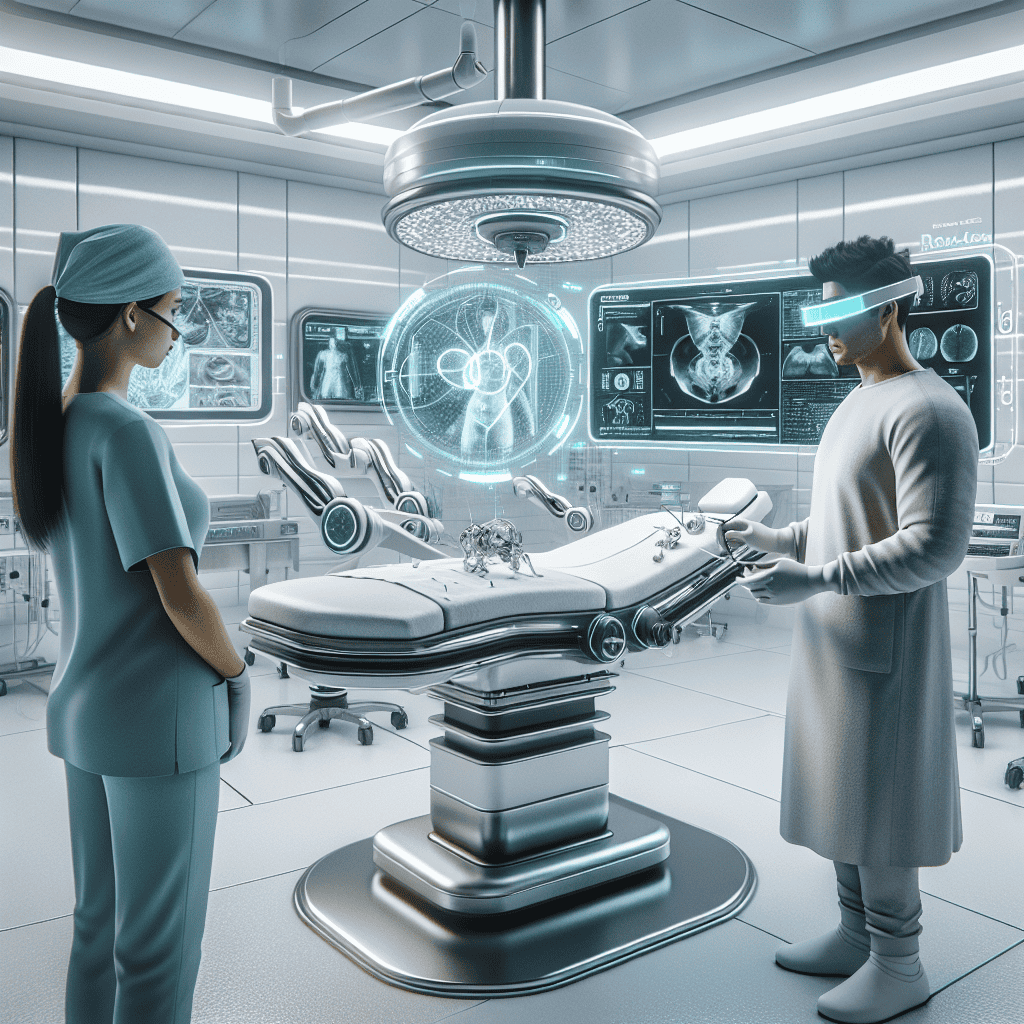Emerging Plastic Surgery Trends for 2025 | Nextech

As we approach 2025, the field of plastic surgery is undergoing significant transformations driven by technological advancements, changing societal norms, and evolving patient expectations. This article explores the emerging trends in plastic surgery that are set to redefine the industry. From innovative techniques to personalized procedures, these trends highlight the future of aesthetic and reconstructive surgery.
1. The Rise of Minimally Invasive Procedures
Minimally invasive procedures have been gaining popularity over the past decade, and this trend is expected to continue into 2025. Patients are increasingly seeking options that offer quicker recovery times, less pain, and minimal scarring. This section delves into the various minimally invasive techniques that are shaping the future of plastic surgery.
1.1 Non-Surgical Facelifts
Non-surgical facelifts are becoming a preferred choice for individuals looking to rejuvenate their appearance without undergoing traditional surgery. Techniques such as thread lifts, laser treatments, and ultrasound therapy are gaining traction due to their ability to provide subtle yet effective results.
Thread lifts, for instance, involve the use of dissolvable sutures to lift and tighten the skin. This procedure offers immediate results with minimal downtime, making it an attractive option for those with busy lifestyles. Similarly, laser treatments and ultrasound therapy stimulate collagen production, resulting in firmer and more youthful skin over time.
1.2 Injectable Treatments
Injectable treatments, including Botox and dermal fillers, continue to dominate the minimally invasive market. These treatments offer quick and effective solutions for reducing wrinkles, enhancing facial contours, and restoring volume.
In 2025, we can expect to see advancements in the formulation and application of injectables. New products with longer-lasting effects and improved safety profiles are likely to emerge, providing patients with more options to achieve their desired look.
1.3 Body Contouring Innovations
Body contouring procedures are evolving with the introduction of non-surgical techniques such as cryolipolysis and radiofrequency treatments. These methods target stubborn fat deposits and tighten the skin without the need for incisions or anesthesia.
Cryolipolysis, commonly known as “fat freezing,” uses controlled cooling to eliminate fat cells, while radiofrequency treatments use heat to stimulate collagen production and tighten the skin. These procedures offer patients a less invasive alternative to traditional liposuction, with fewer risks and shorter recovery times.
1.4 Advances in Laser Technology
Laser technology is playing a pivotal role in the evolution of minimally invasive plastic surgery. From skin resurfacing to hair removal, lasers offer precise and effective solutions for a variety of aesthetic concerns.
In 2025, we can expect to see further advancements in laser technology, including the development of devices that target specific skin types and conditions. These innovations will allow for more personalized treatments and improved outcomes for patients.
1.5 The Role of AI in Minimally Invasive Procedures
Artificial intelligence (AI) is revolutionizing the field of plastic surgery by enhancing the precision and safety of minimally invasive procedures. AI-powered imaging systems can analyze a patient’s facial structure and predict the outcomes of various treatments, allowing surgeons to tailor procedures to individual needs.
Additionally, AI algorithms can assist in the development of new techniques and products, leading to more effective and efficient treatments. As AI continues to advance, its integration into plastic surgery will likely result in improved patient satisfaction and outcomes.
2. Personalized Plastic Surgery: Tailoring Procedures to Individual Needs
Personalization is becoming a key focus in plastic surgery, with patients seeking procedures that are tailored to their unique anatomy and aesthetic goals. This section explores the various ways in which plastic surgery is becoming more personalized, from customized implants to individualized treatment plans.
2.1 Customized Implants
Customized implants are gaining popularity as patients seek more natural-looking results. Advances in 3D printing technology have made it possible to create implants that are specifically designed to fit a patient’s anatomy, resulting in improved comfort and aesthetics.
For example, breast augmentation patients can now opt for implants that are tailored to their body shape and size, providing a more personalized and satisfying outcome. Similarly, facial implants can be customized to enhance specific features, such as the chin or cheekbones, while maintaining a harmonious balance with the rest of the face.
2.2 Genetic Testing and Personalized Treatment Plans
Genetic testing is emerging as a valuable tool in the personalization of plastic surgery. By analyzing a patient’s genetic makeup, surgeons can gain insights into how their body may respond to certain procedures and tailor treatment plans accordingly.
This approach allows for more accurate predictions of surgical outcomes and reduces the risk of complications. For instance, genetic testing can help identify patients who may be prone to excessive scarring or poor wound healing, enabling surgeons to take preventive measures and optimize results.
2.3 Virtual Consultations and 3D Imaging
Virtual consultations and 3D imaging are transforming the way patients and surgeons interact. These technologies allow patients to visualize potential outcomes and make informed decisions about their procedures.
During a virtual consultation, patients can discuss their goals and concerns with their surgeon from the comfort of their own home. 3D imaging software can then create a digital model of the patient’s face or body, allowing them to see how different procedures may alter their appearance.
This level of personalization not only enhances patient satisfaction but also improves communication between patients and surgeons, leading to more successful outcomes.
2.4 The Role of AI in Personalized Surgery
AI is playing a crucial role in the personalization of plastic surgery by analyzing vast amounts of data to identify patterns and trends. This information can be used to develop personalized treatment plans that are tailored to a patient’s unique needs and preferences.
For example, AI algorithms can analyze a patient’s medical history, lifestyle, and aesthetic goals to recommend the most suitable procedures and techniques. This level of personalization ensures that patients receive the best possible care and achieve their desired results.
2.5 The Future of Personalized Plastic Surgery
As technology continues to advance, the future of personalized plastic surgery looks promising. We can expect to see further developments in areas such as 3D printing, genetic testing, and AI, leading to even more tailored and effective treatments.
Ultimately, the goal of personalized plastic surgery is to provide patients with results that are not only aesthetically pleasing but also aligned with their individual needs and preferences. As this trend continues to evolve, it will likely become a standard practice in the field of plastic surgery.
3. The Integration of Technology in Plastic Surgery
Technology is playing an increasingly important role in the field of plastic surgery, with new innovations enhancing the precision, safety, and outcomes of various procedures. This section explores the different ways in which technology is being integrated into plastic surgery, from robotic-assisted surgery to virtual reality training.
3.1 Robotic-Assisted Surgery
Robotic-assisted surgery is revolutionizing the field of plastic surgery by providing surgeons with enhanced precision and control. These systems use robotic arms and advanced imaging technology to perform complex procedures with greater accuracy and minimal invasiveness.
For example, robotic-assisted systems can be used in reconstructive surgeries, such as breast reconstruction or facial reconstruction, to achieve more precise results. The use of robotics also reduces the risk of human error and improves patient safety.
3.2 Virtual Reality Training
Virtual reality (VR) is becoming an invaluable tool in the training and education of plastic surgeons. VR simulations allow surgeons to practice and refine their skills in a realistic and controlled environment, without the need for live patients.
These simulations can replicate a wide range of procedures, from rhinoplasty to liposuction, providing surgeons with the opportunity to gain hands-on experience and improve their technique. As VR technology continues to advance, it will likely become an integral part of surgical training programs.
3.3 Augmented Reality in Surgery
Augmented reality (AR) is another technology that is being integrated into plastic surgery. AR systems overlay digital information onto the real world, providing surgeons with real-time guidance and visualization during procedures.
For instance, AR can be used to project a digital model of a patient’s anatomy onto their body, allowing surgeons to plan and execute procedures with greater precision. This technology has the potential to improve surgical outcomes and reduce the risk of complications.
3.4 AI-Powered Diagnostic Tools
AI-powered diagnostic tools are enhancing the accuracy and efficiency of plastic surgery consultations. These systems use machine learning algorithms to analyze patient data and provide recommendations for suitable procedures and treatments.
For example, AI can analyze a patient’s skin type, age, and lifestyle factors to recommend the most effective skincare treatments or anti-aging procedures. This level of precision ensures that patients receive personalized care and achieve optimal results.
3.5 The Future of Technology in Plastic Surgery
The integration of technology in plastic surgery is set to continue into 2025 and beyond, with new innovations enhancing the precision, safety, and outcomes of various procedures. As technology continues to advance, we can expect to see further developments in areas such as robotics, VR, AR, and AI.
Ultimately, the goal of integrating technology into plastic surgery is to provide patients with the best possible care and outcomes. As these technologies become more widely adopted, they will likely become a standard practice in the field of plastic surgery.
4. The Growing Demand for Gender-Affirming Surgeries
Gender-affirming surgeries are becoming increasingly popular as more individuals seek to align their physical appearance with their gender identity. This section explores the various types of gender-affirming surgeries and the factors driving their growing demand.
4.1 Top Surgery
Top surgery, which involves the removal or augmentation of breast tissue, is one of the most common gender-affirming procedures. This surgery is often sought by transgender individuals who wish to achieve a more masculine or feminine chest appearance.
For transgender men, top surgery typically involves the removal of breast tissue to create a flatter chest. For transgender women, breast augmentation may be performed to enhance breast size and shape. These procedures can have a significant impact on an individual’s self-esteem and quality of life.
4.2 Facial Feminization Surgery
Facial feminization surgery (FFS) is a set of procedures designed to alter masculine facial features to create a more feminine appearance. FFS may include procedures such as rhinoplasty, brow lift, and jaw contouring.
These surgeries are often sought by transgender women who wish to achieve a more feminine facial appearance. FFS can have a profound impact on an individual’s self-confidence and social interactions, making it an important aspect of gender-affirming care.
4.3 Phalloplasty and Metoidioplasty
Phalloplasty and metoidioplasty are surgical procedures that create a neophallus for transgender men. Phalloplasty involves the construction of a penis using tissue from other parts of the body, while metoidioplasty uses existing genital tissue to create a smaller phallus.
These surgeries are complex and require a high level of surgical expertise. However, they can provide transgender men with a sense of completeness and alignment with their gender identity.
4.4 Vaginoplasty
Vaginoplasty is a surgical procedure that creates a neovagina for transgender women. This surgery involves the construction of a vaginal canal and external genitalia using existing genital tissue.
Vaginoplasty can have a significant impact on an individual’s quality of life, providing them with a sense of alignment with their gender identity and improving their sexual health and well-being.
4.5 The Future of Gender-Affirming Surgeries
The demand for gender-affirming surgeries is expected to continue growing as societal acceptance of transgender individuals increases. Advances in surgical techniques and technology will likely improve the safety and outcomes of these procedures, making them more accessible to those who seek them.
Ultimately, gender-affirming surgeries play a crucial role in helping individuals achieve a sense of alignment with their gender identity and improve their overall quality of life. As the field of plastic surgery continues to evolve, these procedures will likely become more widely available and accepted.
5. The Impact of Social Media on Plastic Surgery Trends
Social media is playing a significant role in shaping plastic surgery trends, with platforms like Instagram and TikTok influencing patient expectations and preferences. This section explores the impact of social media on plastic surgery and the trends that are emerging as a result.
5.1 The Influence of Influencers
Social media influencers have a significant impact on plastic surgery trends, with many individuals seeking procedures to emulate the appearance of their favorite influencers. This trend is particularly prevalent among younger generations who are heavily influenced by social media.
Influencers often share their plastic surgery journeys and results with their followers, providing a sense of transparency and relatability. This has led to an increase in demand for procedures such as lip fillers, rhinoplasty, and Brazilian butt lifts.
5.2 The Rise of “Instagram Face”
The concept of “Instagram face” refers to a specific aesthetic that is popularized on social media platforms. This look typically features high cheekbones, full lips, and a defined jawline, often achieved through cosmetic procedures.
The desire to achieve this look has led to an increase in demand for procedures such as dermal fillers, Botox, and jawline contouring. However, it has also raised concerns about the homogenization of beauty standards and the pressure to conform to a specific aesthetic.
5.3 The Role of Filters and Editing Apps
Filters and editing apps are widely used on social media platforms to enhance appearance and create a more polished look. However, these tools can also contribute to unrealistic beauty standards and increase the demand for plastic surgery.
Many individuals seek procedures to achieve the same flawless appearance they see in filtered images, leading to an increase in demand for skin treatments, facial contouring, and other cosmetic procedures.
5.4 The Impact of Social Media on Patient Expectations
Social media has significantly influenced patient expectations when it comes to plastic surgery. Many individuals now seek procedures with the expectation of achieving instant and dramatic results, similar to what they see on social media.
This has led to an increase in demand for minimally invasive procedures that offer quick results with minimal downtime. However, it has also raised concerns about the potential for unrealistic expectations and dissatisfaction with surgical outcomes.
5.5 The Future of Social Media and Plastic Surgery
As social media continues to evolve, its impact on plastic surgery trends is likely to persist. Platforms will continue to shape patient expectations and preferences, influencing the types of procedures that are in demand.
However, it is important for both patients and surgeons to approach social media with a critical eye and prioritize realistic expectations and safe practices. As the field of plastic surgery continues to evolve, it will be crucial to balance the influence of social media with evidence-based practices and patient-centered care.
Conclusion
The field of plastic surgery is undergoing significant transformations as we approach 2025. From minimally invasive procedures to personalized treatments, the trends explored in this article highlight the future of aesthetic and reconstructive surgery. As technology continues to advance and societal norms evolve, the field of plastic surgery will likely continue to adapt and innovate to meet the changing needs and expectations of patients.
Ultimately, the goal of these emerging trends is to provide patients with safe, effective, and personalized care that enhances their quality of life and aligns with their individual goals. As we look to the future, it is clear that the field of plastic surgery will continue to play a crucial role in helping individuals achieve their desired appearance and improve their overall well-being.





